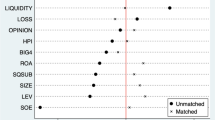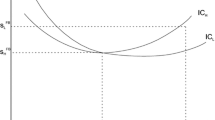Abstract
Frequent monitoring and relatively high fines are usually necessary to bring about improvements in environmental quality, but more challenging for many countries with limited human, material, and financial resources is to put them into practice. This paper developed a three-group model of a state-dependent enforcement in a repeated game to improve the policy implementation under limited inspection capacities. A certain number of firms are grouped (group 1, group 2, group 3) for different supervision intensity (e.g., the order of inspection probability corresponding to each group is p 1 < p 2 < p 3) based on their environmental performance. The optimal policy parameters, such as inspection probability of each group and the probability that a firm found in compliance is moved to a better reputation group, were obtained as the basis for regulator’s policy making. Numerical simulations indicated that the three-group inspection regime can significantly increase compliance rate as compared with static enforcement with the same monitoring probability. Among the number of firms in each group under steady state conditions, group 2 had the most, group 1 was the second, and group 3 had the smallest. Analysis and prediction of a three-group reputation example provided a good experiment for the model. The results give a practical reference for the policy makers with inspection capacity constraints to achieve higher compliance rate.








Similar content being viewed by others
References
Central People’s Government of the People’s Republic of China (CPGPRC). (2015). Law of the people’s republic of China on the prevention and control of water pollution. Approved by the Standing Committee of the National People’s Congress (NPC) of the People’s Republic of China. Available at: http://zfs.mep.gov.cn/fl/201404/t20140425_271040.htm. Accessed November 2015.
Dresher, M. (1962). A sampling inspection problem in arms control agreements: a game-theoretic analysis. Memorandum RM-2972-ARPA. Santa Monica: The RAND Corporation.
Maschler, M. (1966). A price leadership method for solving the inspector’s non-constant sum game. Naval Research Logistics Quarterly, 13, 11–33. doi:10.1002/nav.3800130103.
Ferguson, T. S., & Melolidakis, C. (1998). On the inspection game. Naval Research Logistics, 45, 327–334. doi:10.1002/(SICI)1520-6750(199804)45:3%3C327::AID-NAV6%3E3.3.CO;2-G.
Andreozzi, L. (2004). Rewarding policemen increases crime. Another surprising result from the inspection game. Public Choice, 121, 69–82. doi:10.1007/s11127-004-6166-x.
Dong, X., Li, C., Li, J., Wang, J., & Huang, W. (2010). A game-theoretic analysis of implementation of cleaner production policies in the Chinese electroplating industry. Resources, Conservation and Recycling, 54, 1442–1448. doi:10.1016/j.resconrec.2010.06.009.
Lin, S. W. (2010). Self-reporting mechanism for risk regulation. Journal of Business Research, 63, 528–534. doi:10.1016/j.jbusres.2009.04.011.
Franckx, L. (2002). The use of ambient inspections in environmental monitoring and enforcement when the inspection agency cannot commit itself to announced inspection probabilities. Journal of Environmental Economics and Management, 43(1), 71–92. doi:10.1006/jeem.2000.1167.
Franckx, L. (2005). Environmental enforcement with endogenous ambient monitoring. Environmental and Resource Economics, 30, 195–220. doi:10.1007/s10640-004-1514-3.
Tapiero, C. S. (2004). Environmental quality control and environmental games. Environmental Modeling and Assessment, 9, 201–206. doi:10.1007/s10666-005-2451-4.
Harrington, W. (1988). Enforcement leverage when penalties are restricted. Journal of Public Economics, 37, 29–53. doi:10.1016/0047-2727(88)90003-5.
Harford, J. D. (1991). Measurement error and state-dependent pollution-control enforcement. Journal of Environmental Economics and Management, 21, 67–81. doi:10.1016/0095-0696(91)90005-4.
Harford, J. D., & Harrington, W. (1991). A reconsideration of enforcement leverage when penalties are restricted. Journal of Public Economics, 45, 391–395. doi:10.1016/0047-2727(91)90034-Y.
Raymond, M. (1999). Enforcement leverage when penalties are restricted: a reconsideration under asymmetric information. Journal of Public Economics, 73, 289–295. doi:10.1016/S0047-2727(98)00106-6.
Friesen, L. (2003). Targeting enforcement to improve compliance with environmental regulations. Journal of Environmental Economics and Management, 46, 72–85. doi:10.1016/S0095-0696(02)00033-5.
Liu L. and Neilson W. (2009). Enforcement Leverage with Fixed Inspection Capacity. Available at: http://web.utk.edu/∼wneilson/Leverage.pdf. Accessed November 2015.
Guangdong Environmental Protection Bureau (GDEPB). (2006). Trial Procedures of Guangdong Provincial Environmental Protection Bureau on Credit Management of Key Sources of Pollution for Environmental Protection. Available at: http://www.gdep.gov.cn/zwxx_1/zfgw/shbtwj/201011/t20101118_115501.html. Accessed November 2015.
Guangdong Environmental Protection Bureau (GDEPB). (2005). An announcement on environmental information of the key industrial pollution sources of Provincial control in Guangdong Province in 2005. Available at: http://www.gdep.gov.cn/gzhd/wlwz/wlwzgzdt/201009/t20100929_96957.html. Accessed November 2015.
Guangdong Environmental Protection Bureau (GDEPB). (2010). Credit enquiries of polluting enterprises. Available at: http://pub.gdepb.gov.cn/pub/dchome.jsp?act=db12. Accessed November 2015.
Leach, A. (2006). Regulation by reputation. Computers & Operations Research, 33, 409–425. doi:10.1016/j.cor.2004.06.013.
Acknowledgments
This project research was supported by the National Natural Science Foundation of China (Project No. 51408370) and the special funds of Department of Water Administration Supervision of Shenzhen Municipality (Project No. FF25500066). The author is grateful to the Environmental Protection Bureau of Guangdong Province for the opening of the credit management data of key sources of pollution.
Author information
Authors and Affiliations
Corresponding author
Rights and permissions
About this article
Cite this article
Dong, X., Li, C., Ding, B. et al. Improve Compliance with Limited Resources by a Three-Group Inspection Regime. Environ Model Assess 21, 517–529 (2016). https://doi.org/10.1007/s10666-015-9491-1
Received:
Accepted:
Published:
Issue Date:
DOI: https://doi.org/10.1007/s10666-015-9491-1




